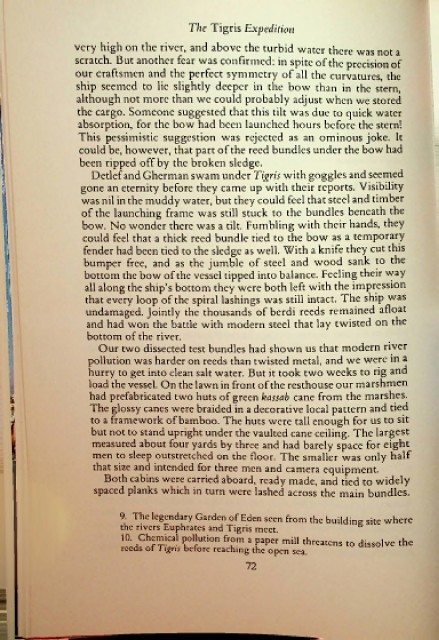Page 83 - The Tigris Expedition
P. 83
The Tigris Expedition
very high on the river, and above the turbid water there was not a
scratch. But another fear was confirmed: in spite of the precision of
our craftsmen and the perfect symmetry of all the curvatures, the
ship seemed to lie slightly deeper in the bow than in the stern,
although not more than we could probably adjust when we stored
the cargo. Someone suggested that this tilt was due to quick water
absorption, for the bow had been launched hours before the stern!
This pessimistic suggestion was rejected as an ominous joke. It
could be, however, that part of the reed bundles under the bow had
been ripped off by the broken sledge.
Detlef and Gherman swam under Tigris with goggles and seemed
gone an eternity before they came up with their reports. Visibility
was nil in the muddy water, but they could feel that steel and timber
of the launching frame was still stuck to the bundles beneath the
bow. No wonder there was a tilt. Fumbling with their hands, they
could feel that a thick reed bundle tied to the bow as a temporary
fender had been tied to the sledge as well. With a knife they cut this
bumper free, and as the jumble of steel and wood sank to the
i
bottom the bow of the vessel tipped into balance. Feeling their way
all along the ship’s bottom they were both left with the impression
that every loop of the spiral lashings was still intact. The ship was
!
undamaged. Jointly the thousands of berdi reeds remained afloat
and had won the battle with modern steel that lay twisted on the
bottom of the river.
Our two dissected test bundles had shown us that modern river
pollution was harder on reeds than twisted metal, and we were in a
hurry to get into clean salt water. But it took two weeks to rig and
load the vessel. On the lawn in front of the resthouse our marshmen
b had prefabricated two huts of green kassab cane from the marshes.
The glossy canes were braided in a decorative local pattern and tied
to a framework of bamboo. The huts were tall enough for us to sit
but not to stand upright under the vaulted cane ceiling. The largest
measured about four yards by three and had barely space for eight
men to sleep outstretched on the floor. The smaller was only half
that size and intended for three men and camera equipment.
Both cabins were carried aboard, ready made, and tied to widely
spaced planks which in turn were lashed across the main bundles.
9. The legendary Garden of Eden seen from the building site where
the rivers Euphrates and Tigris meet.
10 Chemical pollution from a paper mill threatens to dissolve the
reeds of Tigris before reaching the open sea.
72
-
-

